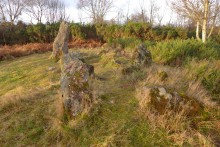|
|
|
|
LeachkinChambered Cairn
|
||||||||||||||||||||||||
|
|
|
Images (click to view fullsize) |
|



|
Fieldnotes |
|
|
29/12/2018 - Day trip to Inverness for a loop round three little tumps. It was a fine walk that also included along the way this chambered cairn and a hillfort later on. We took the Great Glen Way from Inverness to make the steepish climb up to this cairn. It's a little off the path but not too hard to find. Leachkin chambered cairn is of Orkney-Cromarty type. Though just a few stones remain, the entrance and chamber can be made out. The tallest stone is over 6ft in height. Really nice location for this one and I loved the feel of the place, very peaceful in the morning sunshine. The stones are nice. Reddish cobble and boulder conglomerate (Kilmuir Conglomerate Formation formed 385 to 398 million years ago, an age that hurts my head a little to think about). Same stones as under the hillforts of Craig Phadrig and Ord Hill to the north. Well worth a visit if you are passing by. |
 Posted by thelonious
Posted by thelonious30th December 2018ce Edited 11th January 2019ce |
Folklore |
|
The rocks are marked on old maps at NH628437, a short distance from the cairn. There is a well marked close by on the modern OS map, which is conceivably the same mentioned below? Or maybe the water runs straight from the rock?Above the Inverness District Asylum, and immediately below the ascent to Craig Dunain, is "Fuaran a Chragain Bhric," or the Well of the Spotted Rock. This was in former times a place of great resort, the waters, among other healing virtues, being supposed to be strongly diuretic. The bushes around were adorned with rags and threads; while pebbles, pins, and shells might be observed in the bottom of the spring. We have seen one juniper bush close by so loaded with rags and threads as to be hardly distinguishable. This was also a fairy well, and if a poor mother had a puny, weak child, which she supposed had been left by the fairies in place of her own, by exposing it here at night, and leaving some small offering, as a dish of milk, to propitiate the king of fairyland, the bantling would be carried off, and in the morning she would find her own, and restored in health.Quoted by R C Hope in the Antiquary, v 1 (1880). Another description comes from Reminiscences of a Clachnacuddin Nonagenarian (1886, but written 1830), which also mentions another well with an alleged druidic collection with the stones at Leachkin. Fuaran a' Chragan Bhreic, or Well of the Spotted Rock,Somewhere nearby there was another stone with child-related fairy folklore. Canmore summaries its mention in a journal from 1885: The hollow stone lies on the summit on the ridge of Leachkin above the Mental Hospital. The stone is flat and hollow in the centre [and] resembles in size and shape a child's coffin. The greater part remains but the foot is broken or weathered away. At one end it used to be hooded over like a cradle and was known variously as Cradle-stone and Clach-na-shia (Fairies' stone). Alas the OS could not find it in 1962. But I would hope that's not a definitive end to the matter. |
 Posted by Rhiannon
Posted by Rhiannon3rd May 2013ce Edited 3rd May 2013ce |
Links |
|
GeographDon Clode's photo of the chambered cairn. Canmore's description here says the largest stone is 6 feet high, and formed the south side of the cairn's polygonal inner compartment. |
 Posted by Rhiannon
Posted by Rhiannon3rd May 2013ce |

